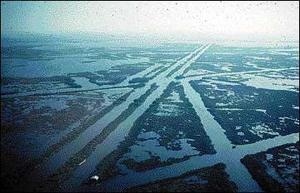Flood protectionLouisiana energy companies sued over destruction of New Orleans' wetlands
The Louisiana oil and gas industry has dredged more than 10,000 miles of canals through the state’s wetlands, causing the destruction of natural buffers and barriers which, in the past, had moderated the impact of hurricanes and protected New Orleans from severe storms. The Army Corps of Engineers has embarked on a $14.6 billion plan to undo some of the damage caused by the energy companies. The plan consists of levee improvement, wetland restoration, and land reclamation to make New Orleans better protected in the face of rising seas and more frequent and severe extreme weather events. The Southeast Louisiana Flood Protection Authority East (SLFPAE) has filed suit against 94energy companies,asking the court to order the companies to do their part to correct the problem they have caused.

Canals cut through wetlands // Source: tamu.edu
The Southeast Louisiana Flood Protection Authority East (SLFPAE), established by Louisiana state law in 2006, is responsible for protecting metropolitan New Orleans east of the Mississippi River. On 24 July the SLFPAE filed suit against Exxon Mobil, BP, Shell, and ninety-four other oil, gas, and pipeline companies for destroying the land and marsh buffer that protected New Orleans from hurricanes. The suit asks the court to order the companies to begin restoring wetland and compensate the authority for past damage.
John Barry, vice president of the authority, writes in the Times-Picayune that part of the compensation could be used to pay the local levee districts’ share of the $14.6 billion levee improvements being made by the Corps of Engineers, and for future storm surge protection projects.
Barry says the suit relies on three legal arguments:
- Most of the damaging oil, gas, and pipeline activities were conducted under federal and state permits which “explicitly require” the operators to maintain and restore the canals they dredged. The oil and gas industry dredged more than 10,000 miles of canals through the state’s wetlands, which provided pathways for saltwater from the Gulf of Mexico to kill fresh and brackish water marshes.
- The Federal Rivers and Harbors Act of 1899 prohibits actions which impair the effectiveness of flood protection levees. “Clearly, increasing storm surge makes a levee less effective,” Barry said.
- A tenet of civil law called “servitude of drainage” prohibits someone taking actions on property that they own or control which sends more water onto someone else’s property. The oil and gas projects clearly focus increased storm surge onto the levee system.
The oil and gas industry is not responsible for the approximately 1,900 square miles of Louisiana’s coastal lands which have disappeared in the past eighty years, but the industry recognizes that its actions and operations are to blame for most of the coastal damages. Thousands of miles of canals and pipelines have been dredged through the marsh, causing saltwater intrusion. In addition, the extraction of an immense volume of oil and gas from beneath the surface has resulted in sunken land.
Chris John, head of Louisiana Mid-Continent Oil and Gas Association agrees that the industry should recognize its role in the loss of land statewide. Studies conducted by industry representatives concluded that the oil and gas industry is responsible for an estimated 36 percent of land loss. According to Barry, the oil and gas industry supports coastal restoration yet has made minimal contribution to fixing it.
Few question the contents claimed in the suit, but the means of restoring the land lost and compensate the authority has not been received well by all. Governor Bobby Jindal claims that the SLFPAE lacks authority to sue, and has called for legislation to interfere with the suit.
